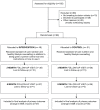Family Intervention for Obese/Overweight Children Using Portion Control Strategy (FOCUS) for Weight Control: A Randomized Controlled Trial
- PMID: 27699184
- PMCID: PMC5030784
- DOI: 10.1177/2333794X16669014
Family Intervention for Obese/Overweight Children Using Portion Control Strategy (FOCUS) for Weight Control: A Randomized Controlled Trial
Abstract
Nutritional counseling for children with obesity is an important component of management. This randomized controlled trial was conducted to compare change in body mass index (BMI) z score after 6 months. Children 8 to 16 years with a BMI greater than the 85th percentile were randomized to standard of care nutrition counseling versus intervention with standard nutrition counseling including portion control tool training for the family. Measures were completed at baseline, 3 months, and 6 months. Fifty-one children were randomized to control and 48 to intervention. Mean age was 11 years (SD = 2.2). Mean BMI z score was 2.7 (SD = 0.4). Forty-five percent were male (n = 45). Follow-up at 6 months was 73.7% (73/99). Although no differences were seen between the groups, there was a significant decrease in BMI z score between baseline and 6 months within each group.
Keywords: management; nutrition; obesity; pediatric; portion size.
Conflict of interest statement
The author(s) declared no potential conflicts of interest with respect to the research, authorship, and/or publication of this article.
Figures


References
-
- Flegal KM, Carroll MD, Ogden CL, Johnson CL. Prevalence and trends in obesity among US adults, 1999-2000. JAMA. 2002;288:1723-1727. - PubMed
-
- Flegal KM, Carroll MD, Kuczmarski RJ, Johnson CL. Overweight and obesity in the United States: prevalence and trends, 1960-1994. Int J Obes Relat Metab Disord. 1998;22:39-47. - PubMed
-
- Flegal KM, Carroll MD, Kit BK, Ogden CL. Prevalence of obesity and trends in the distribution of body mass index among US adults, 1999-2010. JAMA. 2012;307:491-497. - PubMed
-
- Statistics Canada. Overweight and obese adults (self-reported), 2014. http://www.statcan.gc.ca/pub/82-625-x/2015001/article/14185-eng.htm. Accessed March 18, 2016.
LinkOut - more resources
Full Text Sources
Other Literature Sources

